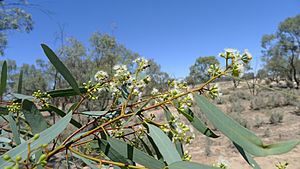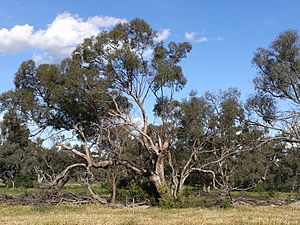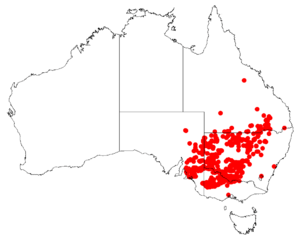River box facts for kids
Quick facts for kids River box |
|
|---|---|
 |
|
 |
|
| Scientific classification | |
| Genus: |
Eucalyptus
|
| Species: |
largiflorens
|
 |
|
| Occurrence data from AVH | |
| Synonyms | |
|
|
The black box or river box (scientific name: Eucalyptus largiflorens) is a special type of tree. It grows only in Australia, meaning it is endemic there. This tree has rough, stringy bark and dull, greenish-grey leaves. Its flower buds are green to yellow and shaped like an oval or club. When it blooms, it has white flowers. After flowering, it produces fruit that looks like a small cup or barrel.
Contents
What Does the Black Box Tree Look Like?
The black box tree can grow quite tall, up to 20 meters (about 65 feet) high. Its bark is dark grey and feels rough, like fibers or flakes. Sometimes, the bark on the main trunk has deep grooves.
Leaves and Flowers
Young black box trees have dull greyish-green or bluish leaves. These leaves are long and narrow, measuring about 40 to 155 millimeters (1.5 to 6 inches) long. As the tree gets older, its leaves become lance-shaped and are the same green color on both sides. Adult leaves are typically 60 to 180 millimeters (2.3 to 7 inches) long.
The flowers of the black box tree grow in small groups, usually with seven to eleven flowers together. These groups appear at the ends of branches or where leaves join the stem. Each flower group sits on a small stalk called a peduncle, which is about 3 to 11 millimeters (0.1 to 0.4 inches) long. Each individual flower also has a tiny stalk, called a pedicel, about 1 to 5 millimeters (0.04 to 0.2 inches) long.
The flower buds are green to yellow and shaped like an oval or club. They are about 4 to 5 millimeters (0.15 to 0.2 inches) long. The top part of the bud, called the operculum, is shaped like a dome or cone. It is shorter and narrower than the main part of the flower cup. Inside the flowers, you'll find white stamens, which are the parts that produce pollen. Black box trees can flower almost any time of the year, but they bloom most often in autumn and spring.
Fruit of the Black Box Tree
After the flowers bloom, they turn into small, round fruits called capsules. These fruits are shaped like a hemisphere or an oval. They are about 3 to 6 millimeters (0.1 to 0.2 inches) long and 3 to 5 millimeters (0.1 to 0.2 inches) wide.
Where Does the Black Box Tree Grow?
The black box tree is found in many parts of Australia. It grows widely across Queensland, New South Wales, Victoria, and South Australia. You can often find it in grassy woodlands, especially on the flat areas near rivers in the Murray–Darling basin. However, it usually prefers drier spots compared to its cousin, the river red gum (E. camaldulensis).
How Indigenous Australians Used the Black Box Tree
Long ago, Indigenous Australians used the small seeds from the black box tree as food, especially when other grass seeds were hard to find. To get the seeds, they would cut down branches with fruit and leave them in the sun. This heat would make the seed capsules open up.
Once the seeds were out, they were soaked in water. The water was changed several times to remove any bitter taste. After soaking, the seeds were dried and then ground into a flour-like substance using a grinding stone. This ground seed was then eaten raw.
See also
 In Spanish: Boj negro para niños
In Spanish: Boj negro para niños

